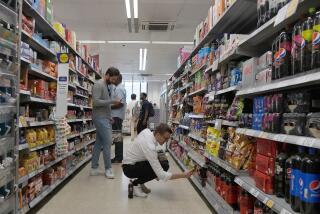In Latin America, prices are jumping
Although economists see little danger of a recurrence of the hyperinflation that undermined the region in the past, Latin America’s rapidly rising prices could undercut its remarkable economic growth and even hurt U.S. hopes for an export-led recovery.
At food stalls in Caracas, Venezuela, gas pumps in Santiago, Chile, and newly minted subdivisions in Sao Paulo, Brazil, prices are rising. In one sense, it’s a sign of good times. Global demand is strong for the region’s oil, coffee, soybeans, copper and other commodities. Latin Americans have money in their pockets and want to spend it.
But sharp price increases could threaten that prosperity, so countries including Brazil, Peru, Colombia and Chile have taken measures to put the brakes on demand to keep inflation in check. Mexico has raised interest rates, Brazil has tightened terms on loans, and Chile has cut back on government spending.
Osvaldo Kacef, a United Nations economist in Santiago, said inflation in the region could average 8% this year, up from 6% last year. He blamed it on the rise in global energy and food prices, which is hitting the region’s poor the hardest.
“Unfortunately Latin America is a region where incomes are uneven and where food and energy costs figure prominently in the household expenses of the poor,” Kacef said.
Still, he said the return of the hyperinflation that devastated some countries in the 1980s and ‘90s isn’t a big concern. Unlike in past boom periods, most Latin American countries have kept tight control on their spending and debt this time.
“Things have changed considerably from 15 years ago, when the political framework was more complex and social pressures were higher,” Kacef said. “Countries have learned their lessons.”
In Brazil, the region’s largest economy, experts predict inflation will reach 6.3% this year, which would be the highest since 2004. Easy credit in recent years has increased demand for cars and housing to the point where the government stepped in last month to introduce tougher lending rules. President Dilma Rousseff also announced a $30-billion cut in public spending this year.
In Chile, where Asian demand for copper has pushed prices to record levels, the economy is expected to grow 6% this year. But inflation is projected to leap to 4.3% in 2011 from 1.7% last year, principally because of higher fuel costs.
In addition to raising interest rates, the Chilean government announced a $750-million reduction in public spending this year. “It’s the government that has to tighten its belt,” said Chile’s finance minister, Felipe Larrain.
In Venezuela, where inflation was a region-high 27% last year, the nation’s central bank expects consumer price increases to slow down this year. That would be welcome news for the country’s shoppers, who have scoured the black market for groceries in recent years.
President Hugo Chavez, who insists high inflation is a “sickness inherited from neoliberal governments” of the past, has instituted credit and import restrictions while expanding price controls through the government’s chain of retail stores, in which the bulk of Venezuela’s foodstuffs is sold.
Critics contend that those measures have reduced incentives for domestic producers to keep shelves stocked, increasing reliance on expensive imports. Chavez recently had to raise the minimum wage by 25% to keep up with price hikes, and introduced a program to sell home appliances at subsidized prices.
Argentina, where inflation trends are going from bad to worse, could take the crown from Venezuela this year for the region’s highest inflation rate. The official figure cited by the government of President Cristina Fernandez de Kirchner is 10%, but many experts say the actual rate is 20% to 25%.
Easy credit is largely to blame and, with a presidential election later this year, observers see little chance of the government putting on the brakes.
“Given the political climate and the upcoming elections, the government is unlikely to take measures to contain the credit-financed consumption boom, as the Brazilian government did earlier this year to slow down inflation, and will probably continue to play down or deny criticisms,” said Laura Gomez-Mera, an economist at the University of Miami.
But even teachers and government worker unions allied with the president haven’t been fooled. They are demanding wage increases of 25% to 40% in new contracts this year.
The International Monetary Fund’s hemispheric director, Nicolas Eyzaguirre, warned in April that unless Argentina’s inflation is reined in, the government may be forced to make deep budget cuts and see sharply lower growth.
Kraul is a special correspondent. Times special correspondents Marcelo Soares in Sao Paulo, Brazil; Mery Mogollon in Caracas, Venezuela; Adriana Leon in Lima, Peru; Fabiola Gutierrez in Santiago, Chile; and Andres D’Alessandro in Buenos Aires, Argentina, contributed to this report.






